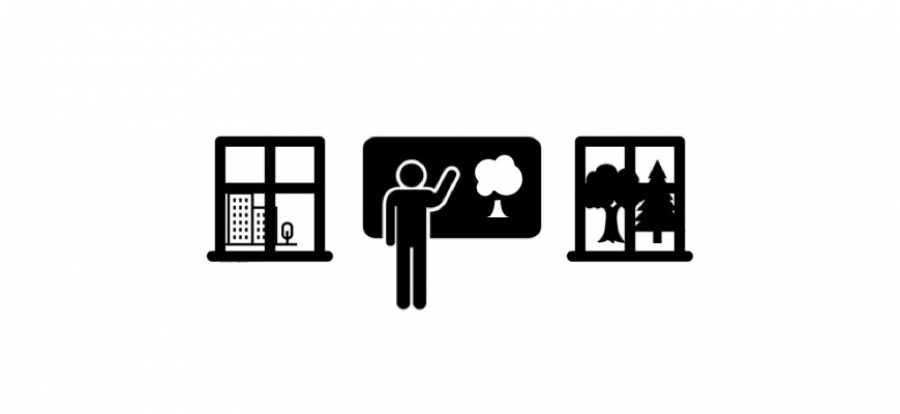I sigh to myself: this teacher is so focused on his teaching that he has forgotten about learning and how to engage children. A “Each learning environment is a reflection of the teacher that ‘governs’ it.”classic case of teachers focusing on ‘effective use of technology’ and the obsession of creating knowledge. This is a lesson about wildlife. It should be about getting outside and utilising what is already there - hundreds of trees, plants and flowers; free resources to engage learners in a real world concept - then to returning to the classroom to review technical vocabulary and species comparison.
Let’s get this straight from the beginning: I am not anti-technology, nor am I anti-knowledge. In fact, quite the opposite: I am slightly obsessed with technology, but I consider myself an advocate for engaging learners in a variety of ways, and not being reliant on one teaching tool... and therein lies the issue.
As an experienced school leader, part of my time now is spent training teachers, meaning I have the privilege of visiting the next generation of educationalists in a myriad of classrooms. Each learning environment is unique, a direct reflection of the teacher that ‘governs’ it, and as a consequence each trainee naturally becomes a mini-me of that teacher. Often, within seconds of a lesson’s start, you get a feeling that the learners are going to be petrified by PowerPoint. Will technology be used as a tool to explain thinking and stimulate learning?
For far too long we have accepted that the most effective way to present knowledge and ideas is to stand in front of a group of students and present concepts to them. This is simply not true. There is little evidence or research that states that expensive technology is the best way to present learning. And yet, nearly every school I have experienced advocates the use of it, champions edtech through staff training and resources. Rarely have I come across a school that not only provides training on technology use, but also teaches how to mindmap, sketchnote and storyboard learning using pen and paper. Some of my best lessons are those where I have supplemented pre-prepared interactive notebooks with flipcharts and sugar-paper illustrations.
Since the rise of the interactive screen replacing projectors in early 2000s, the novelty of such technology in recent years has without question dwindled. Children are “Some teachers are expected to plan using smartboard slides only.”no longer awed by giant interactive screens; they have mini ones of their own in pockets and bedrooms. Indeed, I have watched children in Early Years trying to enlarge images in printed books using a reverse pincer movement. I visit schools as a consultant where teachers are expected to plan using smartboard slides only. I have always doubted the logic of this; it makes no sense. It automatically assumes that a) in every lesson the teacher has a linear sequence of knowledge to transmit, b) learners are automatically engaged by a screen (not true anymore), and c) that sharing information on a screen is a better choice to modelling, writing or discussion.
We wonder how learners have become passive, why they seem to lack resilience and an ability to search for information themselves. I truly believe that they do not. I don’t believe we have a generation of inherently passive learners. In fact, I think we have a generation of inherently passive teachers that rely on overly-scaffolded learning through no fault of their own: it is the only approach they know. The urban legend that expensive technology is superior has somehow permeated their consciousness.
So, in order to skill-up teachers, there are a few simple strategies we can use:
- The Power’s Down!: Insisting teachers not to use anything that requires electricity on a Monday (though only telling them all on the Sunday evening).
- PowerPoint-only Day: Every lesson - from PE to Philosophy, phonics to cooking - has to be taught through the use of IT only.
- Sketchnote and Mindmap: Many new teachers have not experienced or been shown the differences between sketchnoting and mind-mapping, and how they can be used to capture large amounts of knowledge.
- Power of Illustration: Bring an illustrator in to teach teachers (at all levels) how to create basic visual explanations. This is great for students with EAL and SEND.
- Concept Cartoons: Exploring when to use concept cartoons to show teachers that it is as much the verbal reasoning - a key skill being lost in the current generation - than asking learners to read text on a screen… after all what’s the point of being present as a teacher if a student can learn everything from a text?
- Considerate Graphics: Using experiences by designer and dyslexic Sam Barclay (Vimeo short film and beautiful book) to encourage teachers to think about how text and colour can look on a screen if you have a visual impairment or have Dyslexic tendencies.
These approaches really help teachers to reflect on the balance of a variety of teaching methods and when one tool can enhance the other. What we are striving for is a balance between the use of technology to enhance the art and skill of teaching. Not only that, but creating a balance also means reducing the need to find an app for every part of every subject, thus reducing the technology spend and time spent training. We need to treat edtech as a tool for learning, not a crutch for teaching.
Want to receive cutting-edge insights from leading educators each week? Sign up to our Community Update and be part of the action!


















